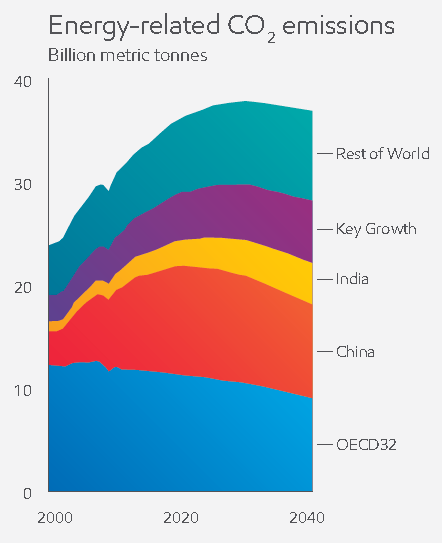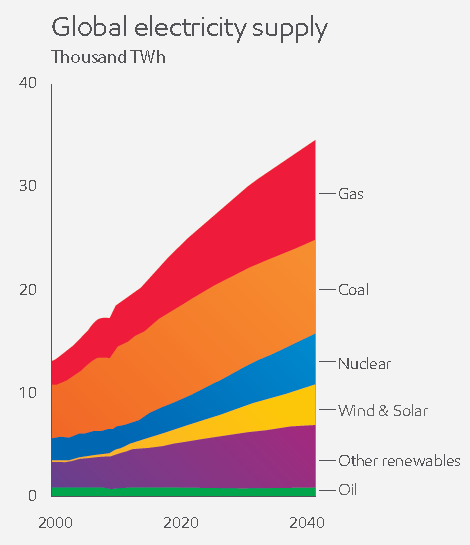ExxonMobil: The Outlook for Energy 2015 … 2040 (Planet Exxon!?)

2015
‘Exxon Mobil Corporation’ from Texas, the United States is, quote: “committed to being the world’s premier petroleum and petrochemical company.” However, based on estimates of the potential carbon dioxide emissions from the proven reserves of oil and gas underground, ExxonMobil is only the 4th largest company in the world after Gazprom, Rosneft (both Russia) and PetroChina (read this ‘article’).
Since the United Nations has decided to keep the rise in global temperature below 2°C and consequently only between 8% and 34% of the proven fossil fuel reserves can be extracted and burned over the next 40 years. A recent ‘study in Nature‘ suggest that, globally, 33% of oil reserves, 50% of gas reserves and over 80% of current coal reserves should remain unused from 2010 to 2050 in order to meet the target of 2°C (also read the article ‘Divestment from Fossil Fuel Companies’). It will be interesting to see how companies such as ExxonMobil meet this moral challenge. The following highlight some forecasts from ExxonMobil’s ‘Outlook for energy 2015: A View to 2040’ (76 pages).
ExxonMobil’s forecast of CO2 Emissions from energy by 2040 is visualized in the diagram below (copied from the report). The emissions are divided into six country groups:
- OECD32 (‘OECD34’ without Mexico and Turkey)
- China
- India
- Key Growth Countries (Mexico, Turkey, Brazil, South Africa, Nigeria, Egypt, Saudi Arabia, Iran, Thailand and Indonesia).
- Rest of the World
ExxonMobil expect global energy-related CO2 Emissions will rise by about 25% from 2010 to 2030 and then decline approximately 5% to 2040. Emissions from non-OECD countries is expected to rise by about 50% from 2010 to 2040 – but on per capita bases emissions in OECD countries will still be about double (in 2040) compared to non-OECD (in 2040). Three billion people are expected to rise into the middle class and at the same time people in nations with more advanced economies will continue to need energy to sustain their living standards and fuel economic growth – consequently, global energy demand is estimated to rise 35% by 2040.
The pathway leading to Planet Exxon (with 20% increase of CO2 Emissions from fossil fuels by 2040 compared to 2010) is described in the report:
- From 2010 to 2040 global electricity demand is expected to increase by about 85 percent as living standards rise and economies expand.
- The demand for fuel to produce electricity is expected to rise by about 50% and natural gas is expected to supply 135% more electricity in 2040 than in 2010.
- Essentially all the growth in global energy demand through 2040 will come from developing countries. China, India and the Key Growth countries will account for 30%, 20% and 30%, respectively.
- In India coal is expected to continue to be the main fuel for power generation, nearly tripling through 2040.
- Natural gas production is expected to grow in almost all regions. Through 2040, a significant portion of this growth is likely to come from unconventional natural gas, particularly shale gas produced in North America.
- North America’s natural gas production is expected to grow by about 75% as its unconventional gas production nearly triples.
- Globally, two-thirds of the increase in natural gas demand through 2040 is forecast to be met by ‘unconventional gas’. By 2040, unconventional supplies are expected to account for 35% of global gas production (compared to 15% in 2010).
- Global demand for oil and liquids is expected to rise by almost 30 percent from 2010 to 2040.
- Three billion people are expected to rise into the middle class and at the same time people in nations with more advanced economies will continue to need energy to sustain their living standards and fuel economic growth. Consequently, global energy demand is estimated to rise 35% from 2010 to 2040.
The ExxonMobil forecast of global electricity supply (by source of energy) 2010-2040 is visualized in the diagram below (copied from the report). Nearly unchanged supply from oil and coal through 2040 is ExxonMobil’s answer to the climate change disaster in progress.
According to ExxonMobil Corporation governments can facilitate development, economic growth and environmental protection through policies that promote free trade and open markets – as well as innovation, private investment and general prosperity. To aid in long-term planning and investment, policy frameworks should be transparent and predictable, with general rules that are easy to understand and applied consistently. Sound regulatory and permitting processes are also important to facilitating Investment.
The home state of Exxon Mobil is Texas in which 25.6 tons of CO2 per capita were emitted in 2011, or 45% above the level of the United States, 321% above the level in China and 1,637% above the level in India … Planet Earth is calling Planet Exxon!
.
ExxonMobil’s ‘Outlook for energy 2015: A View to 2040’.
Read this article in Hoffington Post, Jan. 2015: ‘Carbon Counterattack: How Big Oil Is Responding to the Anti-Carbon Moment‘.
Drawing by Claus Andersen, 2015 (Planet Earth and Planet Exxon).
Comments are closed.

